Abstract
High speed oscilloscopic recordings (4000 mm/sec) of left ventricular pressure (micromanometer) and its first derivative were used to calculate contractile element velocity (Vce) during the isovolumic period of auxotonic beats in anesthetized dogs. At 0.5-2.0 msec intervals of isovolumic systole, Vce was derived as (dP/dt)/kP, where k = 24 cm-1. Plots of Vce and P yielded inverse curves from peak Vce to aortic valve opening pressure which averaged 27 msec in controls, and 11 msec during norepinephrine administration. Extrapolated Vmax, in muscle lengths/second, averaged 3.6 (controls), 3.6 (volume load), and 6.6 (norepinephrine). In each experimental state, Vmax was also determined from force-velocity relations of isovolumic beats (abrupt aortic occlusion) analyzed at 10 msec intervals from conventional pressure recordings. Vmax by both methods correlated well (r = 0.88). While good correlations were also noted between Vmax and maximum dP/dt, (max dP/dt)/integrated isovolumic pressure, (max dP/dt)/peak isovolumic pressure, and (max dP/dt)/kP, only the last two of these successfully distinguished changes between volume load and inotropic stimulation. Thus, assuming an unchanged series elasticity, the contractile state of the auxotonic ventricle may be determined utilizing a single high-fidelity catheter system and high speed recordings of isovolumic pressure.
Full text
PDF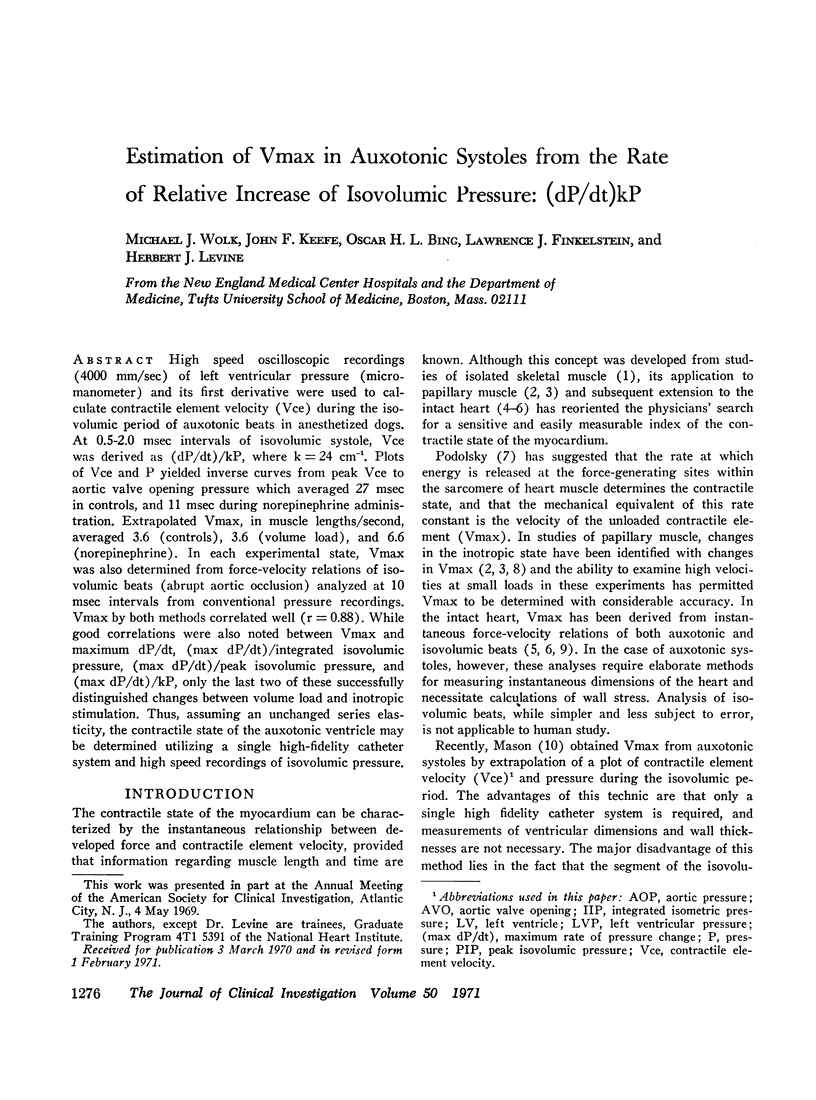
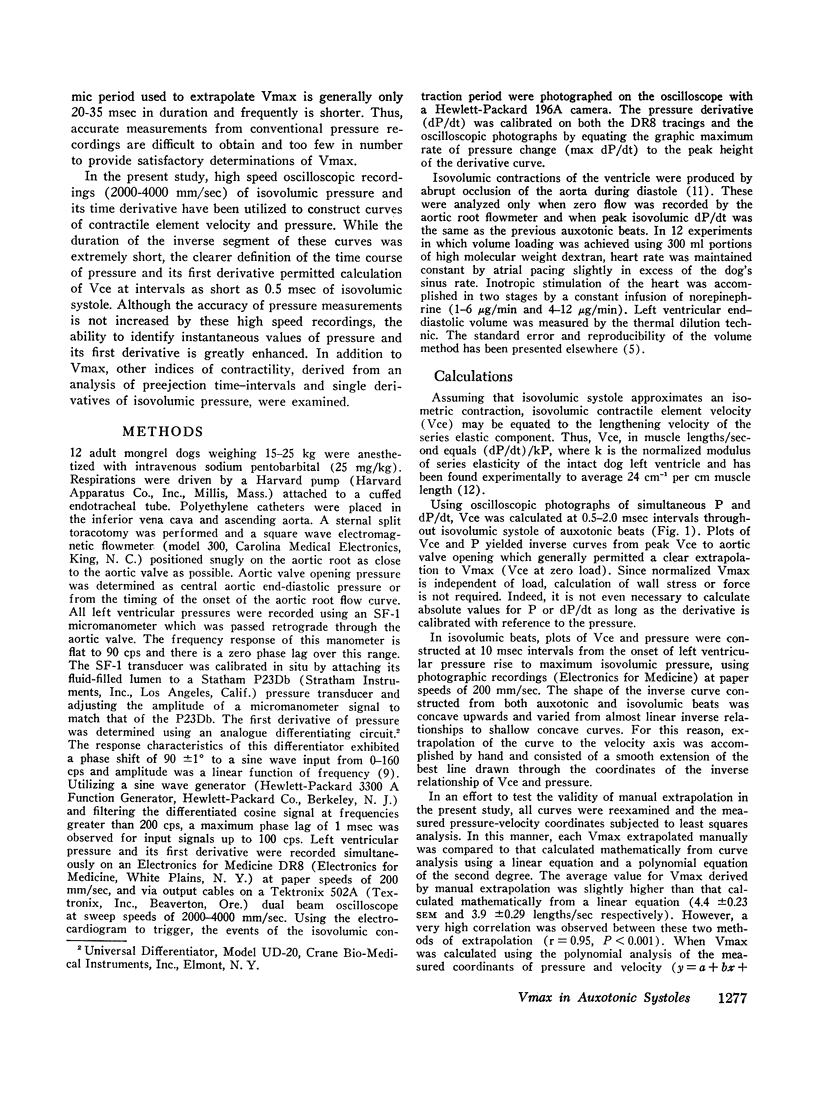
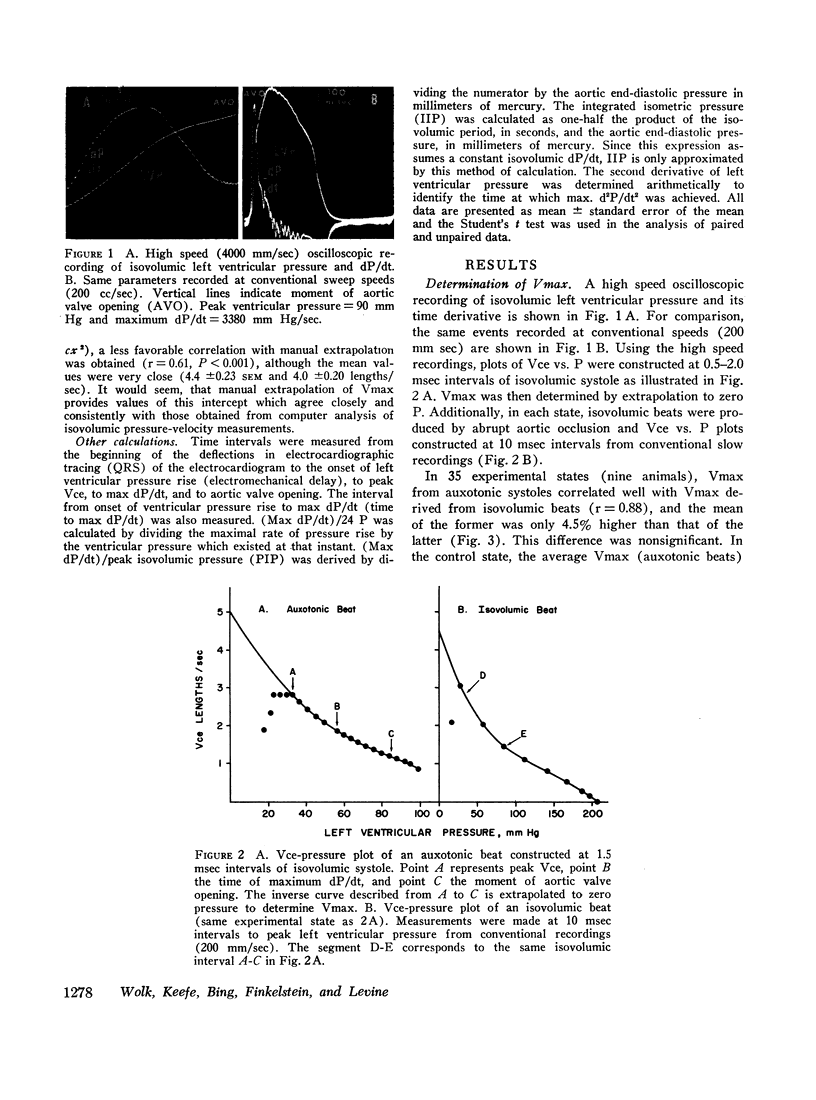
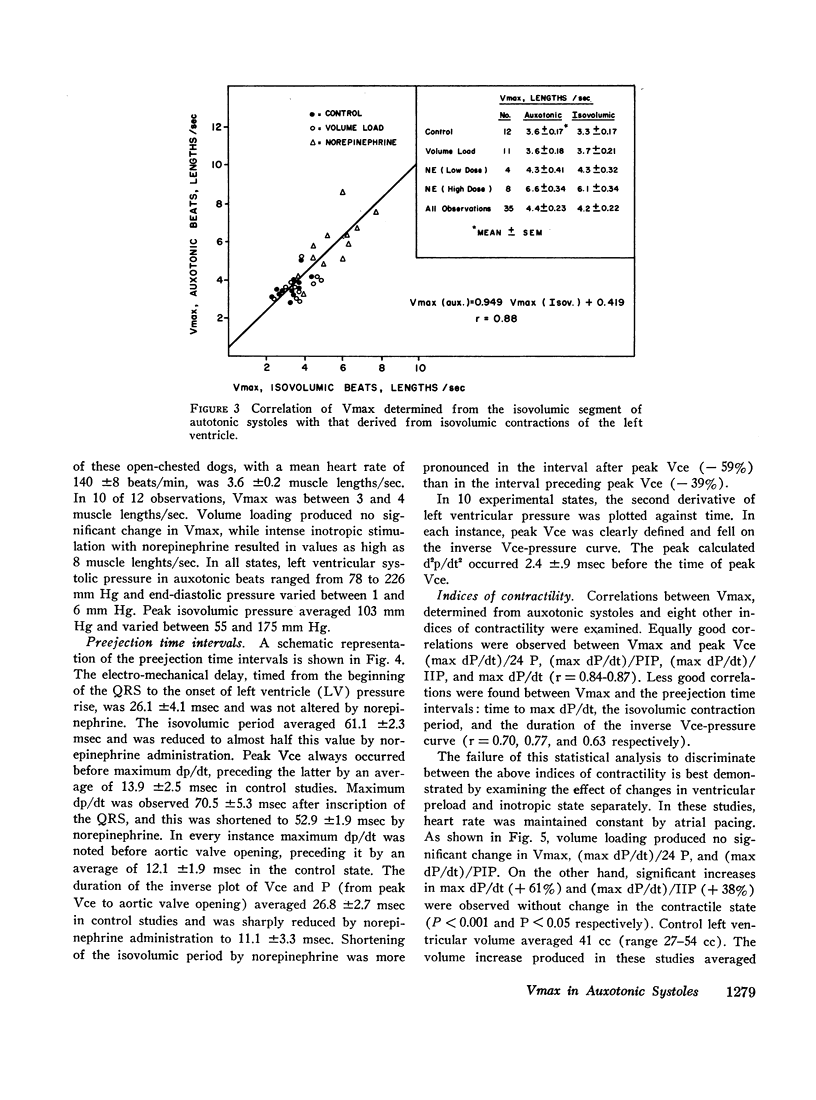
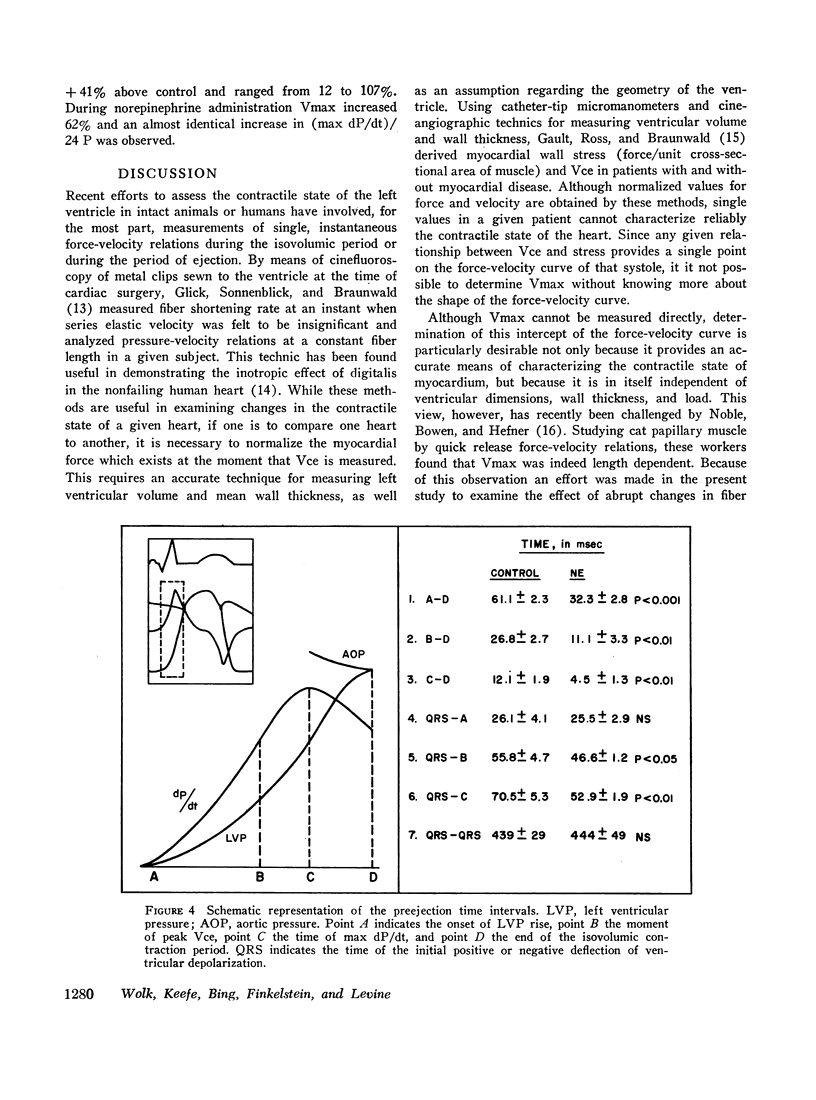
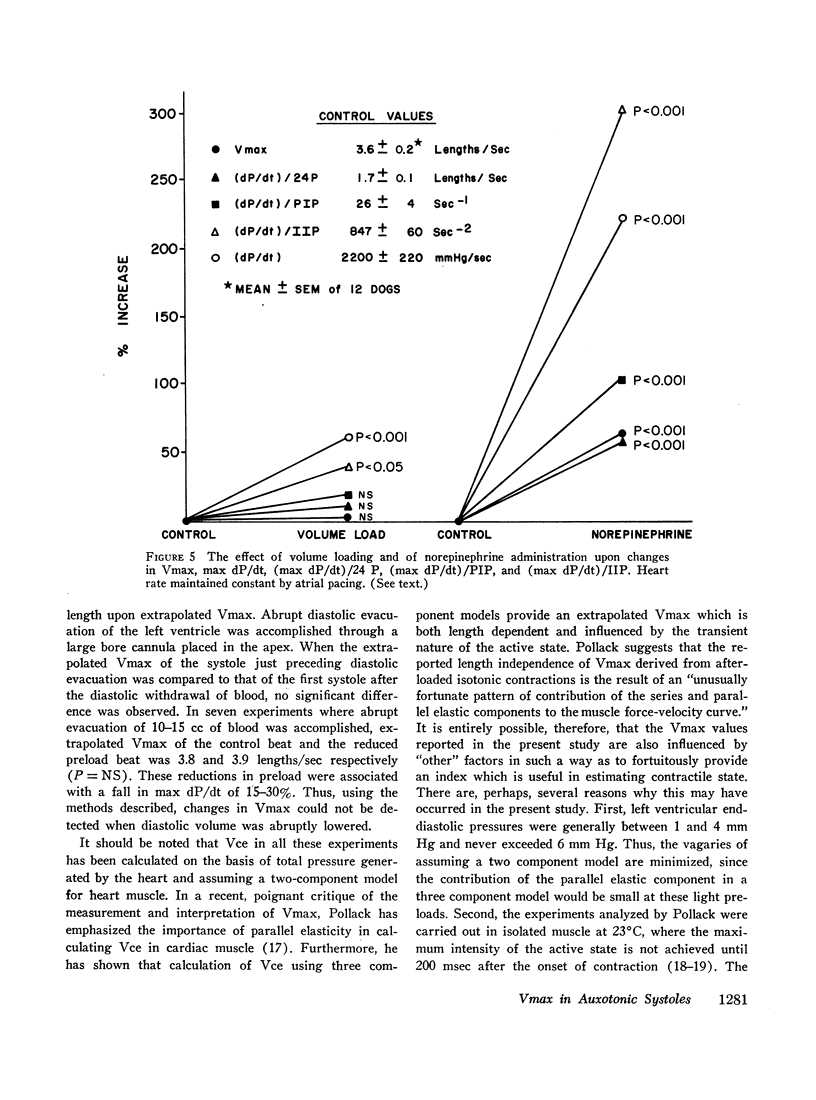
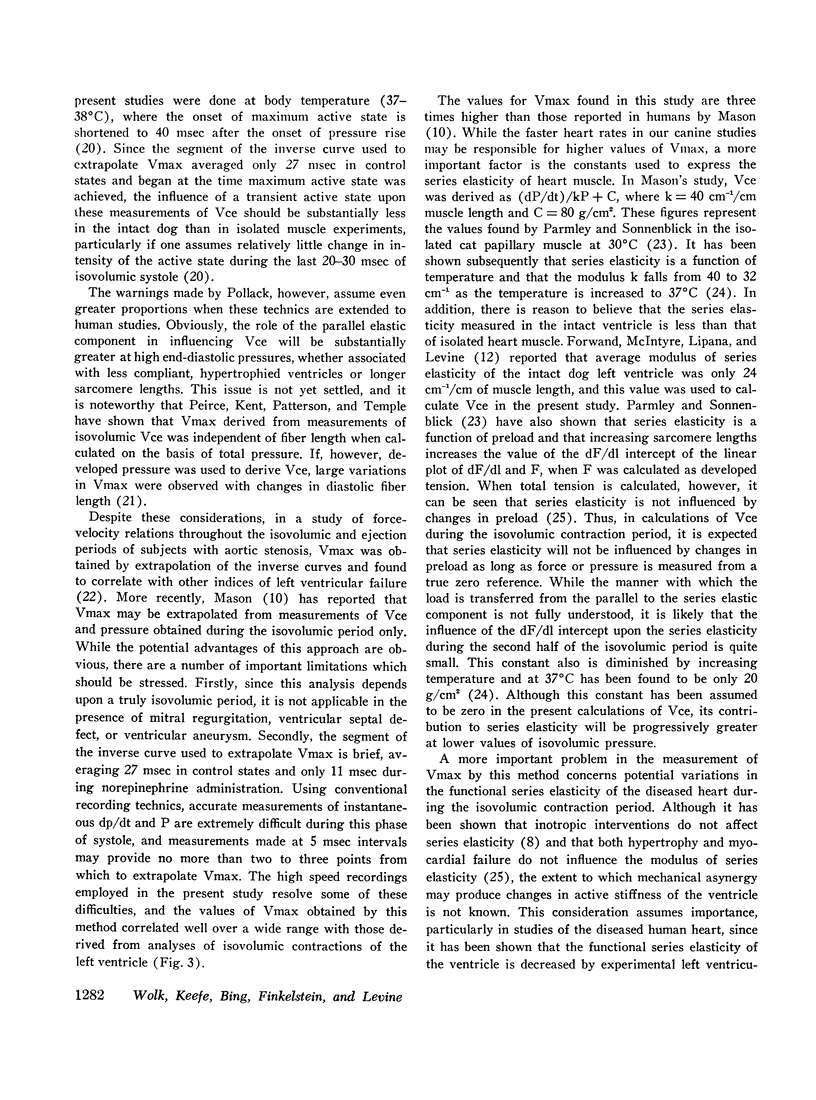
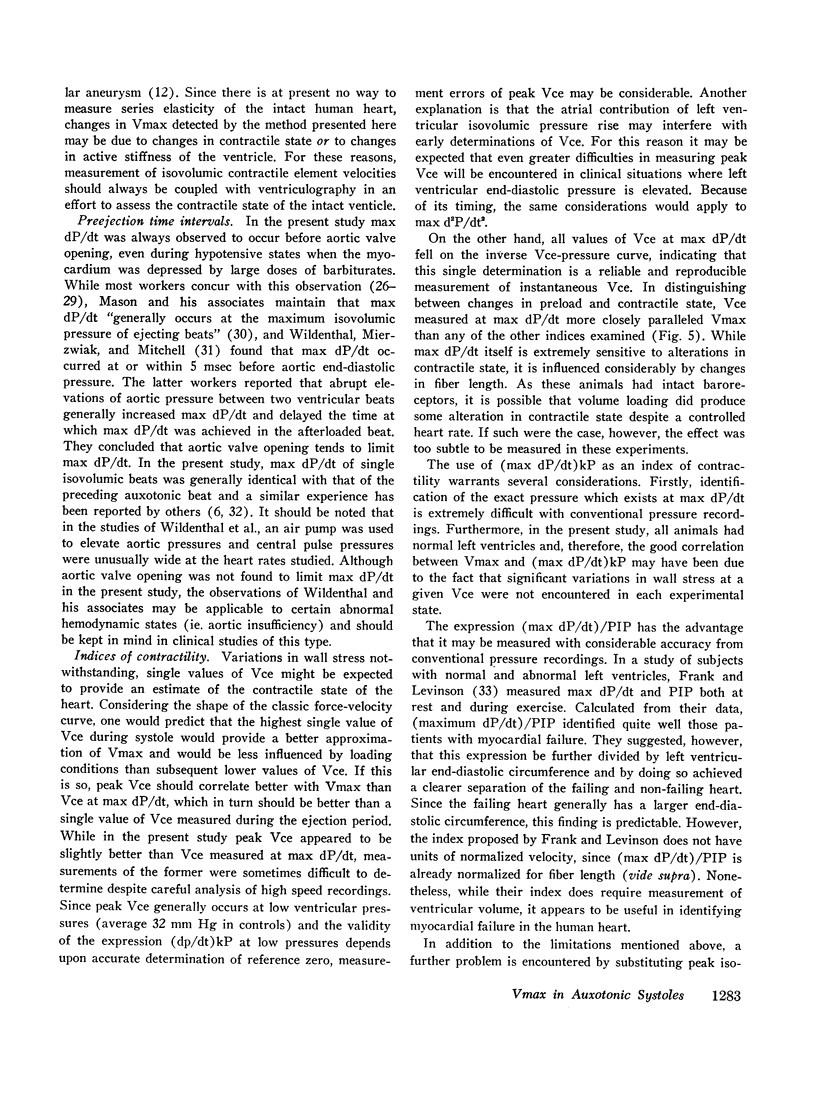
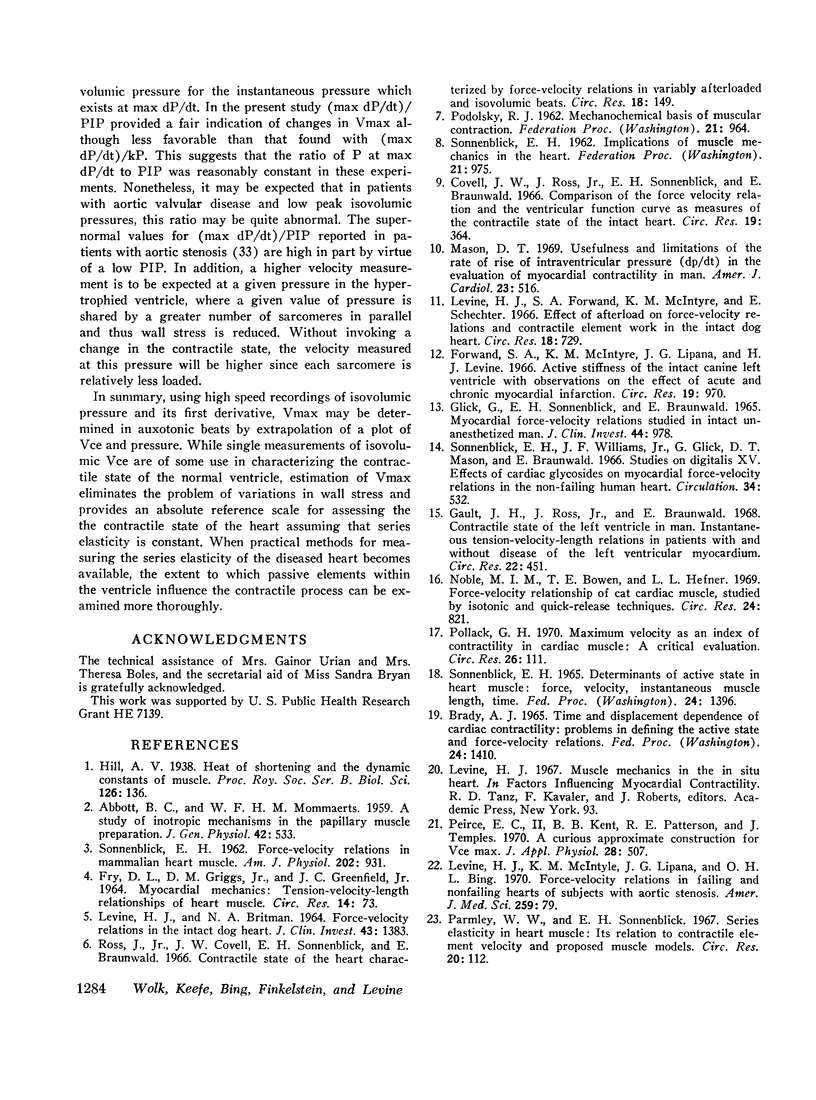
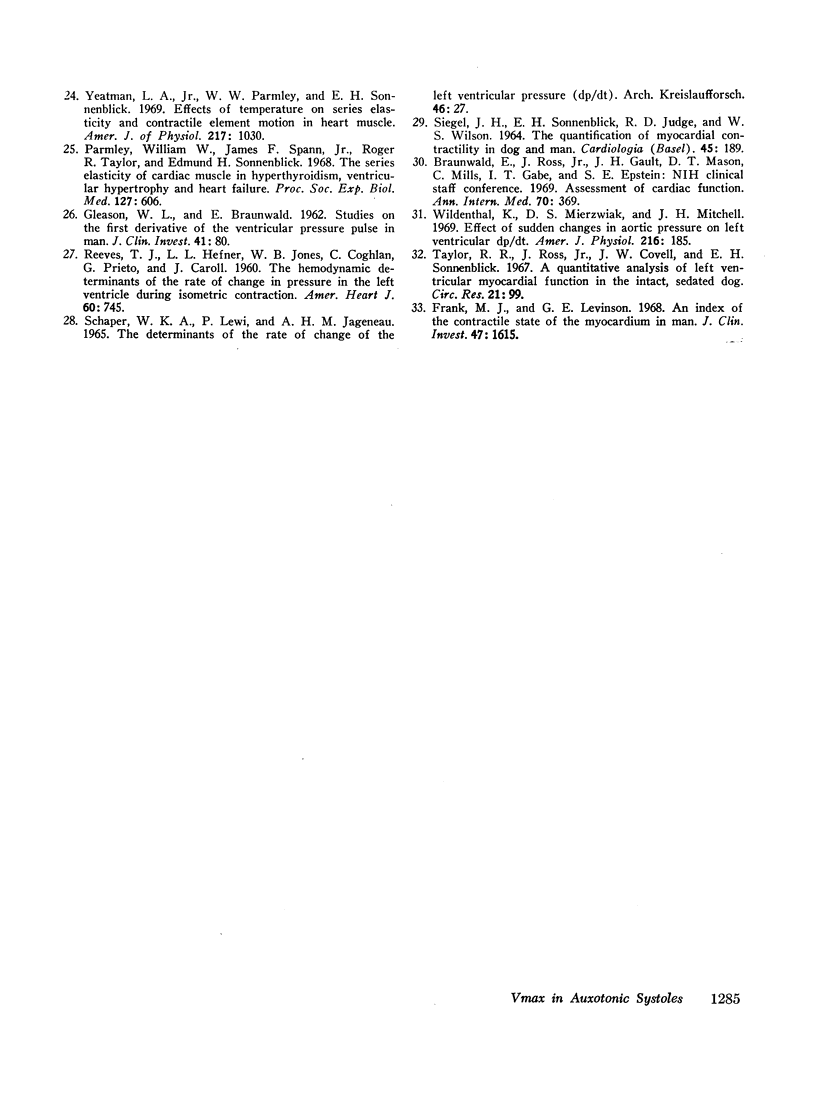
Images in this article
Selected References
These references are in PubMed. This may not be the complete list of references from this article.
- ABBOTT B. C., MOMMAERTS W. F. A study of inotropic mechanisms in the papillary muscle preparation. J Gen Physiol. 1959 Jan 20;42(3):533–551. doi: 10.1085/jgp.42.3.533. [DOI] [PMC free article] [PubMed] [Google Scholar]
- Brady A. J. Time and displacement dependence of cardiac contractility: problems in defining the active state and force-velocity relations. Fed Proc. 1965 Nov-Dec;24(6):1410–1420. [PubMed] [Google Scholar]
- Braunwald E., Ross J., Jr, Gault J. H., Mason D. T., Mills C., Gabe I. T., Epstein S. E. NIH clinical staff conference. Assessment of cardiac function. Ann Intern Med. 1969 Feb;70(2):369–399. doi: 10.7326/0003-4819-70-2-369. [DOI] [PubMed] [Google Scholar]
- Covell J. W., Ross J., Jr, Sonnenblick E. H., Braunwald E. Comparison of the force-velocity relation and the ventricular function curve as measures of the contractile state of the intact heart. Circ Res. 1966 Aug;19(2):364–372. doi: 10.1161/01.res.19.2.364. [DOI] [PubMed] [Google Scholar]
- FRY D. L., GRIGGS D. M., Jr, GREENFIELD J. C., Jr MYOCARDIAL MECHANICS: TENSION-VELOCITY-LENGTH RELATIONSHIPS OF HEART MUSCLE. Circ Res. 1964 Jan;14:73–85. doi: 10.1161/01.res.14.1.73. [DOI] [PubMed] [Google Scholar]
- Forwand S. A., McIntyre K. M., Lipana J. G., Levine H. J. Active stiffness of the intact canine left ventricle. With observations on the effect of acute and chronic myocardial infarction. Circ Res. 1966 Nov;19(5):970–979. doi: 10.1161/01.res.19.5.970. [DOI] [PubMed] [Google Scholar]
- Frank M. J., Levinson G. E. An index of the contractile state of the myocardium in man. J Clin Invest. 1968 Jul;47(7):1615–1626. doi: 10.1172/JCI105853. [DOI] [PMC free article] [PubMed] [Google Scholar]
- GLEASON W. L., BRAUNWALD E. Studies on the first derivative of the ventricular pressure pulse in man. J Clin Invest. 1962 Jan;41:80–91. doi: 10.1172/JCI104469. [DOI] [PMC free article] [PubMed] [Google Scholar]
- GLICK G., SONNENBLICK E. H., BRAUNWALD E. MYOCARDIAL FORCE-VELOCITY RELATIONS STUDIED IN INTACT UNANESTHETIZED MAN. J Clin Invest. 1965 Jun;44:978–988. doi: 10.1172/JCI105215. [DOI] [PMC free article] [PubMed] [Google Scholar]
- Gault J. H., Ross J., Jr, Braunwald E. Contractile state of the left ventricle in man: instantaneous tension-velocity-length relations in patients with and without disease of the left ventricular myocardium. Circ Res. 1968 Apr;22(4):451–463. doi: 10.1161/01.res.22.4.451. [DOI] [PubMed] [Google Scholar]
- LEVINE H. J., BRITMAN N. A. FORCE-VELOCITY RELATIONS IN THE INTACT DOG HEART. J Clin Invest. 1964 Jul;43:1383–1396. doi: 10.1172/JCI105014. [DOI] [PMC free article] [PubMed] [Google Scholar]
- Levine H. J., Forwand S. A., McIntyre K. M., Schechter E. Effect of afterload on force-velocity relations and contractile element work in the intact dog heart. Circ Res. 1966 Jun;18(6):729–744. doi: 10.1161/01.res.18.6.729. [DOI] [PubMed] [Google Scholar]
- Levine H. J., McIntyre K. M., Lipana J. G., Bing O. H. Force-velocity relations in failing and nonfailing hearts of subjects with aortic stenosis. Am J Med Sci. 1970 Feb;259(2):79–89. doi: 10.1097/00000441-197002000-00002. [DOI] [PubMed] [Google Scholar]
- Mason D. T. Usefulness and limitations of the rate of rise of intraventricular pressure (dp-dt) in the evaluation of myocardial contractility in man. Am J Cardiol. 1969 Apr;23(4):516–527. doi: 10.1016/0002-9149(69)90005-8. [DOI] [PubMed] [Google Scholar]
- Noble M. I., Bowen T. E., Hefner L. L. Force-velocity relationship of cat cardiac muscle, studied by isotonic and quick-release techniques. Circ Res. 1969 Jun;24(6):821–833. doi: 10.1161/01.res.24.6.821. [DOI] [PubMed] [Google Scholar]
- PODOLSKY R. J. Mechanochemical basis of muscular contraction. Fed Proc. 1962 Nov-Dec;21:964–974. [PubMed] [Google Scholar]
- Parmley W. W., Sonnenblick E. H. Series elasticity in heart muscle. Its relation to contractile element velocity and proposed muscle models. Circ Res. 1967 Jan;20(1):112–123. doi: 10.1161/01.res.20.1.112. [DOI] [PubMed] [Google Scholar]
- Parmley W. W., Spann J. F., Jr, Taylor R. R., Sonnenblick E. H. The series elasticity of cardiac muscle in hyperthyroidism, ventricular hypertrophy, and heart failure. Proc Soc Exp Biol Med. 1968 Feb;127(2):606–609. doi: 10.3181/00379727-127-32753. [DOI] [PubMed] [Google Scholar]
- Peirce E. C., 2nd, Kent B. B., Patterson R. E., Temples J. A curious approximate construction for VCEmax. J Appl Physiol. 1970 Apr;28(4):507–509. doi: 10.1152/jappl.1970.28.4.507. [DOI] [PubMed] [Google Scholar]
- Pollack G. H. Maximum velocity as an index of contractility in cardiac muscle. A critical evaluation. Circ Res. 1970 Jan;26(1):111–127. doi: 10.1161/01.res.26.1.111. [DOI] [PubMed] [Google Scholar]
- REEVES T. J., HEFNER L. L., JONES W. B., COGHLAN C., PRIETO G., CARROLL J. The hemodynamic determinants of the rate of change in pressure in the left ventricle during isometric contraction. Am Heart J. 1960 Nov;60:745–761. doi: 10.1016/0002-8703(60)90358-6. [DOI] [PubMed] [Google Scholar]
- SCHAPER W. K., LEWI P., JAGENEAU A. H. THE DETERMINANTS OF THE RATE OF CHANGE OF THE LEFT VENTRICULAR PRESSURE (DP/DT). Arch Kreislaufforsch. 1965 Mar;46:27–41. doi: 10.1007/BF02120168. [DOI] [PubMed] [Google Scholar]
- SIEGEL J. H., SONNENBLICK E. H., JUDGE R. D., WILSON W. S. THE QUANTIFICATION OF MYOCARDIAL CONTRACTILITY IN DOG AND MAN. Cardiologia. 1964;45:189–221. doi: 10.1159/000168110. [DOI] [PubMed] [Google Scholar]
- SONNENBLICK E. H. Force-velocity relations in mammalian heart muscle. Am J Physiol. 1962 May;202:931–939. doi: 10.1152/ajplegacy.1962.202.5.931. [DOI] [PubMed] [Google Scholar]
- SONNENBLICK E. H. Implications of muscle mechanics in the heart. Fed Proc. 1962 Nov-Dec;21:975–990. [PubMed] [Google Scholar]
- Sonnenblick E. H. Determinants of active state in heart muscle: force, velocity, instantaneous muscle length, time. Fed Proc. 1965 Nov-Dec;24(6):1396–1409. [PubMed] [Google Scholar]
- Sonnenblick E. H., Williams J. F., Jr, Glick G., Mason D. T., Braunwald E. Studies on digitalis. XV. Effects of cardiac glycosides on myocardial force-velocity relations in the nonfailing human heart. Circulation. 1966 Sep;34(3):532–539. doi: 10.1161/01.cir.34.3.532. [DOI] [PubMed] [Google Scholar]
- Taylor R. R., Ross J., Jr, Covell J. W., Sonnenblick E. H. A quantitative analysis of left ventricular myocardial function in the intact, sedated dog. Circ Res. 1967 Jul;21(1):99–115. doi: 10.1161/01.res.21.1.99. [DOI] [PubMed] [Google Scholar]
- Wildenthal K., Mierzwiak D. S., Mitchell J. H. Effect of sudden changes in aortic pressure on left ventricular dp/dt. Am J Physiol. 1969 Jan;216(1):185–190. doi: 10.1152/ajplegacy.1969.216.1.185. [DOI] [PubMed] [Google Scholar]
- Yeatman L. A., Jr, Parmley W. W., Sonnenblick E. H. Effects of temperature on series elasticity and contractile element motion in heart muscle. Am J Physiol. 1969 Oct;217(4):1030–1034. doi: 10.1152/ajplegacy.1969.217.4.1030. [DOI] [PubMed] [Google Scholar]



